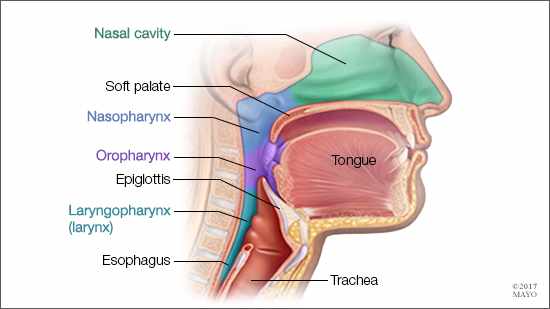-
Mayo Clinic Q and A: Throat cancer symptoms
 DEAR MAYO CLINIC: Are there early signs of throat cancer, or is it typically not found until its late stages? How is it treated?
DEAR MAYO CLINIC: Are there early signs of throat cancer, or is it typically not found until its late stages? How is it treated?
ANSWER: The throat includes several important structures that are relied on every minute of the day and night to breathe, swallow and speak. Unfortunately, cancer can involve any, and sometimes all, of these structures. The symptoms of cancer, how early these symptoms are recognized and how the cancer is treated depend on which structures are involved.
All of the passageway between your tongue and your esophagus can be considered the throat. It includes three main areas. The first is the base of your tongue and tonsils. These, along with the soft palate and upper side walls of the pharynx, are called the oropharynx. Second is the voice box, or larynx. It consists of the epiglottis — a cartilage flap that helps to close your windpipe, or trachea, when you swallow — and the vocal cords. Third is the hypopharynx. That includes the bottom sidewalls and the back of the throat before the opening of the esophagus.
Tumors that occur in these three areas have different symptoms, behave differently and often are treated differently. That’s why the areas of the throat are subdivided into separate sections by the head and neck surgeons who diagnose and treat them.
For example, in the oropharynx, most tumors are squamous cell carcinoma. Most are caused by HPV, although smoking and alcohol can play a role in causing some of these tumors. Cancer that occurs in this area, particularly when caused by HPV, grows slowly ─ usually over a number of months. It often does not cause pain, interfere with swallowing or speaking, or have many other symptoms.
Most people discover cancer in the oropharynx when they notice a mass in their neck that’s a result of the cancer spreading to a lymph node. Eighty percent of people with cancer that affects the tonsils and base of tongue are not diagnosed until the cancer moves into the lymph nodes.
This type of cancer responds well to therapy, however, and is highly treatable even in an advanced stage. At Mayo Clinic, most tonsil and base of tongue cancers are treated by removing the cancer and affected lymph nodes with robotic surgery, followed by radiation therapy. This treatment attains excellent outcomes without sacrificing a person’s ability to swallow.
When cancer affects the voice box, it often affects speech. People usually notice hoarseness in their voice soon after the cancer starts. Because of that, many cases of this cancer are detected at an early stage. People with hoarseness that lasts for six weeks should get an exam by an otolaryngologist who specializes in head and neck cancer treatment, as early treatment of voice box cancer is much more effective than treatment in the later stages.
Early voice box cancer is treated with surgery — often laser surgery — or radiation therapy. Both are highly effective. If left untreated, voice box cancer can grow and destroy more of the larynx. At that point, treatment usually includes major surgery, along with radiation and chemotherapy ─ often at great cost to speech and swallowing function.
Finally, cancer of the hypopharynx usually involves symptoms such as pain when swallowing and difficulty swallowing solid food. It is most common in people with a long history of tobacco smoking and daily alcohol consumption. This cancer almost always presents in an advanced stage. Treatment is usually a combination of surgery, chemotherapy and radiation therapy.
If you are concerned about the possibility of any of these cancers, or if you notice symptoms that affect your speech or swallowing, make an appointment for an evaluation. The earlier cancer is diagnosed, the better the chances for successful treatment. — Dr. Eric Moore, Otorhinolaryngology, Mayo Clinic, Rochester, Minnesota







